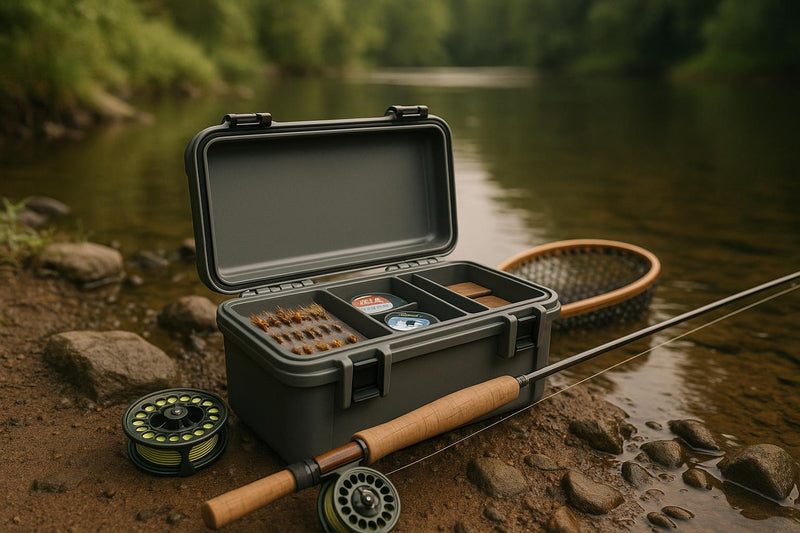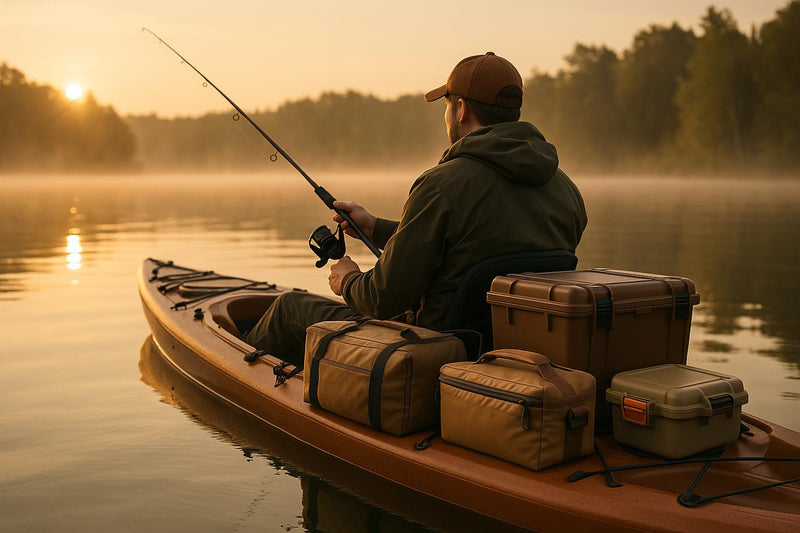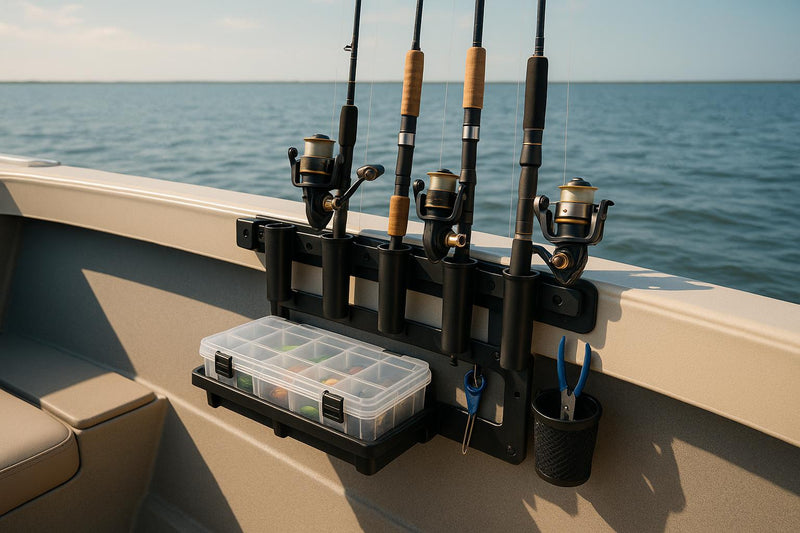If you're tired of dealing with rusted hooks, soggy lures, or damaged fishing gear, waterproof storage is the solution you need. It protects your equipment from moisture caused by rain, splashes, or humidity, saving you money and frustration. Beyond protection, it keeps your gear organized and easily accessible, so you can focus on fishing instead of searching through a wet, messy tackle box.
Here’s what you’ll learn:
- Why waterproof storage matters for preserving metal components, fishing lines, and electronics.
- The best types of waterproof storage: hard cases, soft pouches, dry bags, and fishing gear organizers.
- Key features to look for, like durable materials, effective seals, and portability.
- How fishing clothing with water-resistant pockets adds convenience and extra protection.
Whether you’re fishing from a boat, shore, or kayak, choosing the right waterproof storage ensures your equipment stays in top condition, ready for action.
Types of Waterproof Storage Options
Protecting your fishing gear from water damage is essential, and there’s no shortage of storage solutions designed to meet different conditions and fishing needs. Let’s take a closer look at some of the most reliable options, starting with hard cases.
Hard Cases
Hard cases are a solid choice for waterproof protection. These rigid containers, equipped with O-ring seals, create a tight barrier that keeps water, dust, and debris out. Many models also come with modular compartments, letting you organize gear of various sizes and types. Their durable design isn’t just about keeping things dry - it also provides impact resistance, making them perfect for sensitive equipment like fish finders, GPS devices, or underwater cameras.
Soft Pouches and Dry Bags
For those looking for a lightweight alternative, soft pouches and dry bags are excellent options. Roll-top dry bags are particularly popular - they seal securely when rolled and clipped, offering a snug fit that conforms to your gear. They’re easy to stash in tight spaces like tackle bags or boat compartments. Waterproof pouches, on the other hand, are great for smaller essentials like fishing licenses, maps, spare leaders, or backup electronics. Many feature clear windows for quick identification and attachment points for lanyards or carabiners, making them both practical and versatile.
If you’re after more tailored solutions, specialized fishing gear organizers might be the way to go.
Fishing Gear Organizers
Fishing organizers are designed with anglers in mind, combining storage with moisture protection. Take bait binders, for instance - these slim cases are perfect for storing soft plastic baits in individual compartments, keeping them neatly arranged and easy to access. Some even come with drainage holes to let water escape while still protecting the contents. Tackle organizers with waterproof seals are another great option. They often include multiple compartments, so if one section is compromised, the rest of your gear stays dry. Smaller accessory organizers are ideal for items like split rings, swivels, and crimps, offering quick, one-handed access. Many of these organizers are compatible with modern fishing apparel that features water-resistant pockets, such as Reel Comfort’s fishing shorts or men’s fishing shorts, providing a seamless way to manage your gear.
Each of these storage solutions serves a specific purpose, ensuring your gear stays protected and organized while you’re out on the water.
What to Look for in Waterproof Storage
When it comes to keeping your gear safe from moisture, the right waterproof storage can make all the difference. To get reliable protection, pay attention to specific design features that ensure your items stay dry and secure.
Seal Type and Water Protection
The seal is the frontline defense against water. Different seal designs provide varying levels of protection, so it's important to choose wisely. O-ring seals are a standout option, forming an airtight, watertight barrier around the container's edges.
Take the Plano Waterproof 3700 Stowaway Tackle Box, for example. With its O-ring seal and durable cam-action latches, it’s a customer favorite. As of September 2025, it earned a 4.7 out of 5 stars rating from 7,595 Amazon reviews, with over 700 units sold in just one month.
"Water is the enemy when it comes to fishing tackle storage. There's nothing worse than finding your valuable fishing tackle in a tackle box full of water, and it's covered in rust. Protect your tackle and gear from moisture with Whisker Seeker Tackle Waterproof Stow & Go tackle boxes. Designed to withstand the harshest conditions, the boxes feature a 360° Dura-Dry O-ring seal and tight-sealing cam latches."
Another effective option is silicone seals, which work especially well for tackle boxes with multiple compartments. The Baitium Waterproof Tackle Box, equipped with XTRASeal technology, is a great example. It holds a 4.7 out of 5 stars rating from 160 reviews. One verified customer, Scott Bright, shared his experience in April 2024:
"The silicone seals keep the water out" and "Latches on three sides keep it closed and secure."
When evaluating seal systems, don’t overlook the latch mechanism. Cam-action latches, in particular, complement seals by applying consistent pressure along the container’s edges. For added security, look for three-latch systems, which provide an extra layer of reliability. Finally, assess the materials and overall construction to ensure your storage solution can withstand long-term use.
Material and Build Quality
The materials used in your waterproof storage matter just as much as the seals. Look for impact-resistant plastics that balance durability, weight, and water resistance. For metal components like hinges and latches, corrosion-resistant materials such as stainless steel or marine-grade aluminum are excellent choices, especially for saltwater environments.
If you’re considering soft storage options, prioritize reinforced waterproof fabrics with welded seams. Welded seams are far superior to stitched ones, as they reduce the risk of leaks. Additionally, consistent wall thickness and precise assembly can significantly improve the durability and performance of your storage.
Size, Portability, and Fit
Your waterproof storage should integrate seamlessly with your gear and setup. Whether it’s fitting into your tackle bag, boat compartments, or even pairing with your fishing apparel, compact designs are key. For example, modern fishing shorts often feature water-resistant pockets that work well with smaller waterproof organizers, keeping essential items both accessible and protected.
Other practical features to look for include stackability - containers with flat tops and bottoms or interlocking designs help prevent sliding during transport. Also, consider the balance between weight and protection. Heavier cases may offer better durability, but they can be cumbersome for long trips or hikes. Many modern storage solutions now include portability features like ergonomic handles, shoulder straps, or carabiner attachment points to make carrying easier.
Ultimately, the best waterproof storage is the one that fits your fishing style and gear needs, ensuring your items stay dry and secure even in tough conditions.
sbb-itb-cb0a783
How to Maintain Waterproof Storage
Keeping your waterproof gear in great condition starts with proper storage. Pairing smart storage practices with the durable materials and seal systems we've already discussed ensures your gear stays reliable for the long haul.
Storage and Temperature Tips
Always store your tackle boxes and other gear in a cool, dry place to shield them from moisture and temperature-related damage. Steer clear of extreme temperatures and high humidity, as these can compromise the integrity of your waterproof storage solutions. Proper storage is the first step, but cleaning and regular inspections are just as important for extending the life of your gear.
Choosing the Right Waterproof Storage for Your Needs
Having the right waterproof storage can be the difference between an enjoyable fishing trip and dealing with waterlogged, damaged gear. To make the best choice, consider what kind of fishing you’ll be doing and what your gear demands.
Hard cases are ideal for protecting expensive electronics like fish finders, GPS units, and cameras. These sturdy cases are especially useful for boat anglers or those with extra vehicle storage, as they offer excellent protection against both impacts and water. On the other hand, soft pouches and dry bags are perfect when portability and weight are key - great for wade fishing, kayak fishing, or trekking to remote spots. For organizing your tackle, fishing gear organizers keep lures, hooks, and other small items dry and neatly arranged, offering a versatile solution for various fishing scenarios.
When choosing storage, don’t just focus on the type - pay attention to features that ensure long-term protection. Look for durable materials, strong seals, and a size that accommodates your gear without being overly bulky. Even the highest waterproof rating won’t matter if the storage doesn’t fit seamlessly into your fishing setup.
Final Recommendations
Your waterproof storage should work hand-in-hand with your overall fishing gear and apparel. Pairing it with functional fishing shorts ensures your essentials stay accessible and dry. High-quality Mens Fishing Shorts can also enhance comfort and mobility during long outings.
For boat anglers, hard cases for electronics combined with medium-sized tackle organizers are a winning combination. Shore and wade fishermen benefit from lightweight dry bags paired with compact tackle pouches that fit conveniently in cargo pockets, keeping essential items within reach. Kayak anglers often find that compact, floating storage systems work best. Using multiple smaller containers instead of one large case can make better use of the tight space in a kayak cockpit. The storage pockets in quality Mens Fishing Shorts can also hold small waterproof pouches, cutting down on trips to your main storage.
Lastly, consider the environment where you’ll be fishing. Saltwater anglers should prioritize storage that resists corrosion, while freshwater anglers might opt for lighter-duty options. Tailoring your storage to local conditions ensures your gear stays safe and ready for action.
FAQs
What’s the difference between hard cases and soft pouches for storing fishing gear?
Hard cases are built from durable materials like plastic or metal, providing strong protection against impacts, crushing, and punctures. They’re a great choice for keeping delicate or high-end fishing gear safe. The downside? They tend to be bulkier and heavier, which can make them less convenient to carry around.
Soft pouches, by contrast, are made from flexible, water-resistant materials such as nylon or PVC. These are lightweight, easy to carry, and simple to pack, making them a handy option for smaller items or when space is limited. However, they don’t offer as much impact resistance as hard cases, so they’re better for gear that doesn’t need heavy-duty protection.
What can I do to keep my waterproof storage gear working effectively over time?
To keep your waterproof storage gear working as it should, make it a habit to inspect seals, zippers, and materials for any signs of wear or damage. If you spot anything that’s worn out or broken, repair or replace it right away to ensure your gear stays waterproof.
After every fishing trip, take the time to clean and completely dry your storage containers, especially if they’ve come into contact with saltwater or dirt. This simple step can help prevent issues like corrosion and mold. When not in use, store your gear in a cool, dry spot, away from direct sunlight, to protect it from material breakdown.
Taking these steps will help keep your gear dependable for many fishing trips ahead.
What factors should I consider when selecting waterproof storage for saltwater and freshwater fishing?
When picking waterproof storage for your fishing gear, it's important to consider the environment you'll be in. For saltwater fishing, choose corrosion-resistant materials like treated aluminum or waterproof resin to handle exposure to salt. Make sure the storage includes sealed seams and waterproof zippers to keep your gear dry and safe.
In freshwater settings, you can usually go with lighter, more flexible waterproof options. But for saltwater conditions, durability is a must - look for heavy-duty designs that can stand up to the tougher environment. To keep your storage in good shape, rinse it with fresh water after each use. This simple step can go a long way in extending its lifespan.




